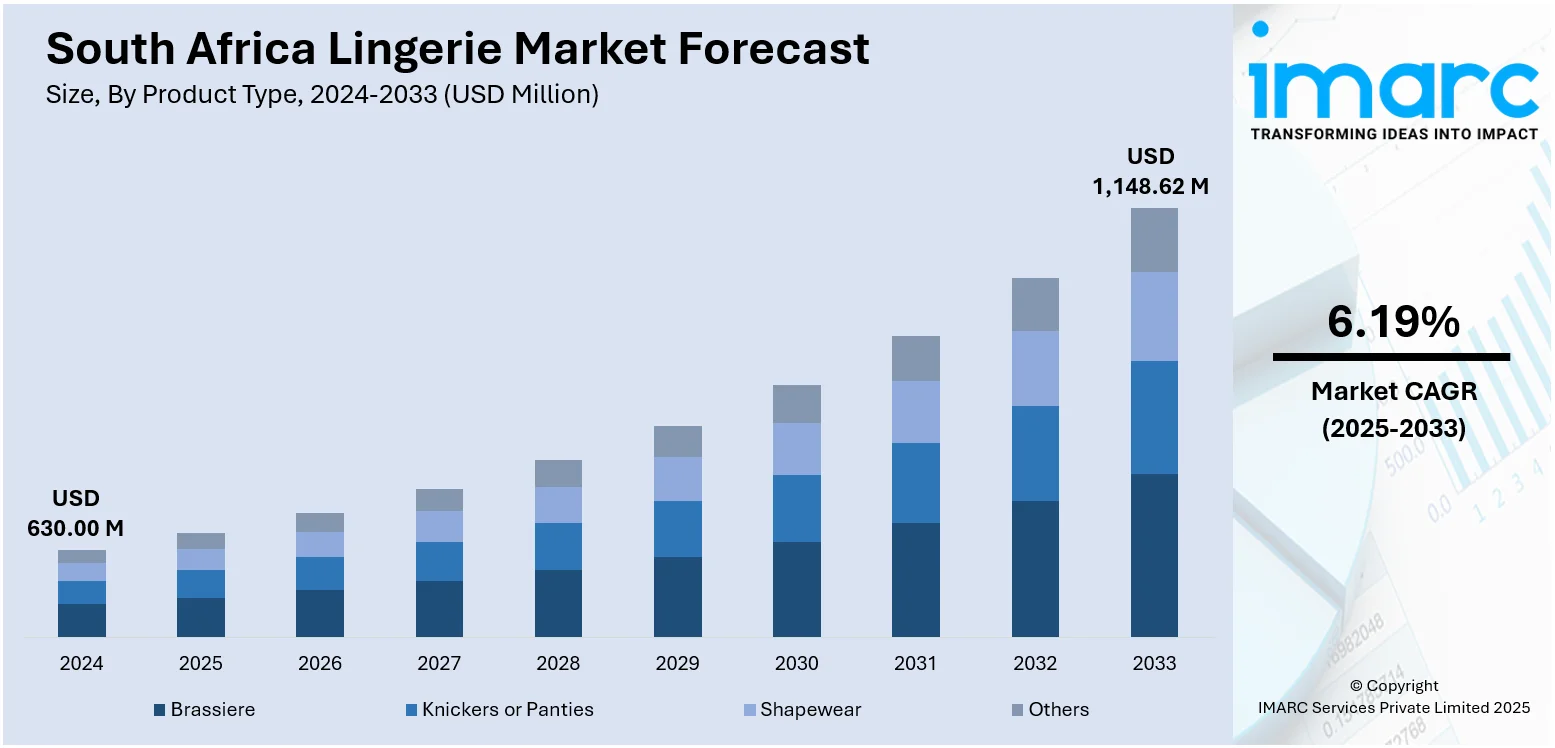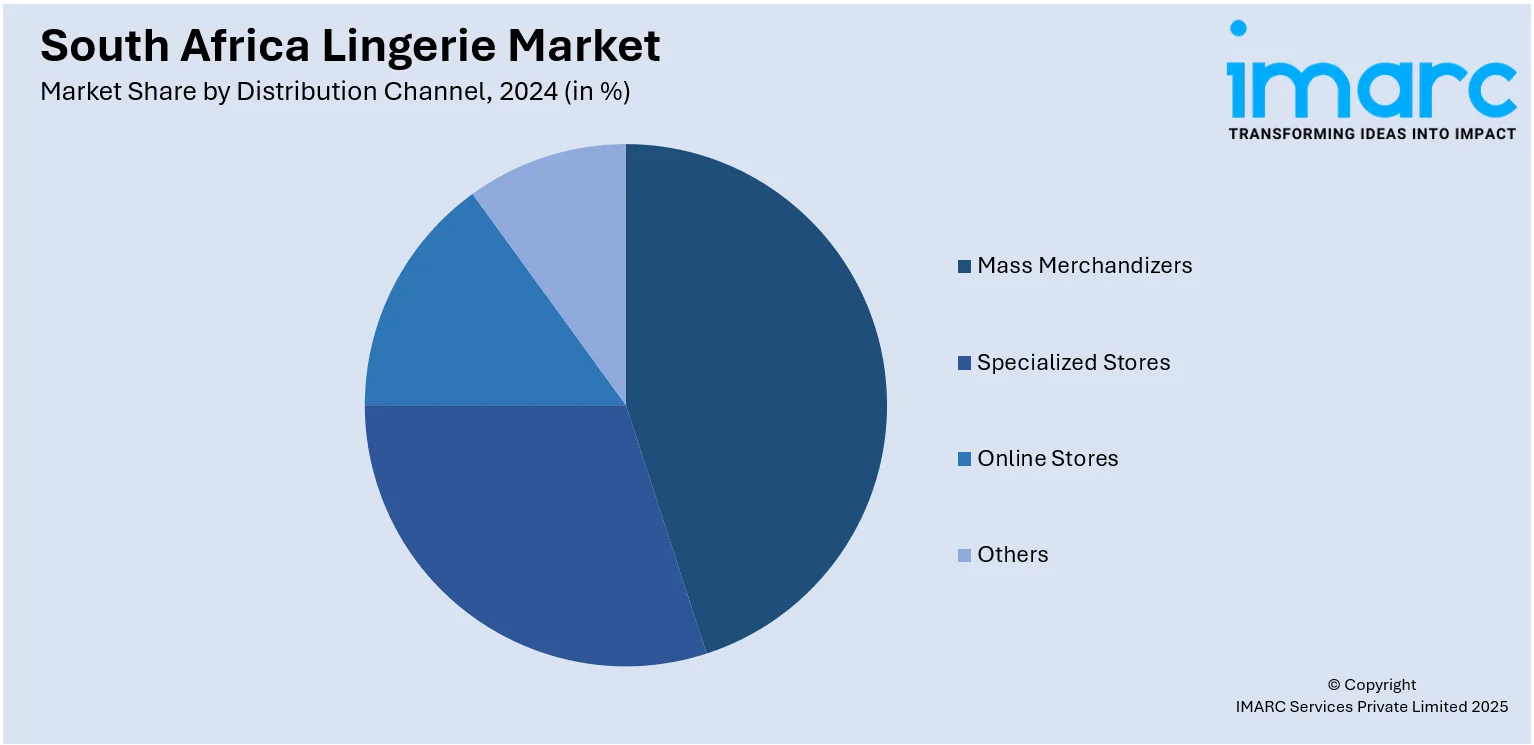
South Africa Lingerie Market Size, Share, Trends and Forecast by Product Type, Material, Price Range, Distribution Channel, and Province, 2025-2033
South Africa Lingerie Market Overview:
The South Africa lingerie market size reached USD 630.00 Million in 2024. The market is projected to reach USD 1,148.62 Million by 2033, exhibiting a growth rate (CAGR) of 6.19% during 2025-2033. The market is driven by increasing consumer concern for personal looks and fashion awareness among South African consumers, especially urban women. Apart from that, increasing disposable incomes and expanding working women's participation have also intensified demand for both functional and luxury lingerie. Moreover, the fast development of online e-commerce platforms and social media advertising has also provided global lingerie brands with better accessibility, which is augmenting the South Africa lingerie market share.
|
Report Attribute
|
Key Statistics
|
|---|---|
|
Base Year
|
2024
|
|
Forecast Years
|
2025-2033
|
|
Historical Years
|
2019-2024
|
| Market Size in 2024 | USD 630.00 Million |
| Market Forecast in 2033 | USD 1,148.62 Million |
| Market Growth Rate 2025-2033 | 6.19% |
South Africa Lingerie Market Trends:
Rising Influence of Body Positivity and Inclusive Sizing
The market is experiencing a massive transformation fueled by the body positivity trend and growing interest in inclusive sizing. Customers are actively looking for lingerie that not only provides visual appeal but also comfort and body support for a wide variety of body types. In addition, domestic and global brands are broadening their product range to cover a broader range of sizes, including plus-size and differently shaped consumers. Moreover, retailers are also reformulating their advertising campaigns to highlight realistic body images, with models of different sizes, skin tones, and shapes to appeal to a wider array of consumers. This is further supported by increasing social consciousness and activism for self-acceptance, particularly among young consumers. As a result, traditional notions of beauty and ideal body standards are being replaced by more inclusive ideals. Besides enhancing brand loyalty, this change is also revealing new market opportunities in urban and semi-urban South Africa.

To get more information on this market, Request Sample
Growth of Online Lingerie Retail and Digital Engagement
The digital transformation of retail is positively impacting the South Africa lingerie market growth. This is fueled by the widespread usage of smartphones, increased internet penetration, and enhanced digital payment infrastructure. According to industry reports, as of January 2024, South Africa boasted 45.34 million internet users and an internet penetration rate of 74.7%. Online retailers provide the benefits of privacy, convenience, and access to more brands and styles, which make them most attractive to young, technology-literate consumers. The lingerie brands are also using digital marketing channels like influencer partnerships, Instagram campaigns, and artificial intelligence-powered recommendation engines to increase customer interaction. Aside from this, online fitting tools and size charts have also reduced the problem of product returns, hence fostering consumer trust in online shopping. This digital trend is further complemented by incentives like sales of limited duration, subscription boxes, and rewards programs, which have made consumers buy more frequently. The trend is also changing consumer behavior, forcing retailers to adopt omnichannel strategies to remain competitive.
Demand for Sustainable and Locally Produced Lingerie
Sustainability has emerged as a defining trend in the market as environmentally conscious consumers increasingly prioritize ethical sourcing and eco-friendly materials. This shift in consumer preference is driving brands to implement sustainable production methods, including organic cotton, bamboo fibers, and recycled packaging. In addition, South African consumers are also increasingly inclined to support local producers that implement fair labor conditions and mitigate carbon emissions through local supply chains. Along with this, the "Made in South Africa" mark has become popular among values-driven customers who appreciate authenticity, artisanal workmanship, and social contribution. Further, several local brands are specifically enlightening consumers on the environmental value of eco-friendly lingerie through marketing media. Retailers also include sustainability labels and certifications to enhance brand trust. This is part of the worldwide move towards responsible fashion and is affecting consumer purchasing behavior not only by high-income consumers but also middle-class consumers for affordable but ethical alternatives.
South Africa Lingerie Market Segmentation:
IMARC Group provides an analysis of the key trends in each segment of the market, along with forecasts at the country and regional levels for 2025-2033. Our report has categorized the market based on product type, material, price range, and distribution channel.
Product Type Insights:
- Brassiere
- Knickers or Panties
- Shapewear
- Others
The report has provided a detailed breakup and analysis of the market based on the product type. This includes brassiere, knickers or panties, shapewear, and others.
Material Insights:
- Cotton
- Silk
- Satin
- Nylon
- Others
A detailed breakup and analysis of the market based on the material have also been provided in the report. This includes cotton, silk, satin, nylon, and others.
Price Range Insights:
- Economy
- Premium
The report has provided a detailed breakup and analysis of the market based on the price range. This includes economy and premium.
Distribution Channel Insights:

- Mass Merchandizers
- Specialized Stores
- Online Stores
- Others
A detailed breakup and analysis of the market based on the distribution channel have also been provided in the report. This includes mass merchandizers, specialized stores, online stores, and others.
Province Insights:
- Gauteng
- KwaZulu-Natal
- Western Cape
- Mpumalanga
- Eastern Cape
- Others
The report has also provided a comprehensive analysis of all the major regional markets, which include Gauteng, KwaZulu-Natal, Western Cape, Mpumalanga, Eastern Cape, and others.
Competitive Landscape:
The market research report has also provided a comprehensive analysis of the competitive landscape. Competitive analysis such as market structure, key player positioning, top winning strategies, competitive dashboard, and company evaluation quadrant has been covered in the report. Also, detailed profiles of all major companies have been provided.
South Africa Lingerie Market News:
- On 7 November 2024, Jockey South Africa launched its new Comfort Bra, specifically designed to deliver all-day support and enhanced ease of wear. The bra features wide, cushioned shoulder straps intended to reduce pressure and provide improved comfort, particularly for women with larger bust sizes. This product launch highlights Jockey’s continued focus on consumer-driven innovation and reinforces its commitment to offering functional yet supportive lingerie solutions in the South African market.
South Africa Lingerie Market Report Coverage:
| Report Features | Details |
|---|---|
| Base Year of the Analysis | 2024 |
| Historical Period | 2019-2024 |
| Forecast Period | 2025-2033 |
| Units | Million USD |
| Scope of the Report |
Exploration of Historical Trends and Market Outlook, Industry Catalysts and Challenges, Segment-Wise Historical and Future Market Assessment:
|
| Product Types Covered | Brassiere, Knickers or Panties, Shapewear, Others |
| Materials Covered | Cotton, Silk, Satin, Nylon, Others |
| Price Ranges Covered | Economy, Premium |
| Distribution Channels Covered | Mass Merchandizers, Specialized Stores, Online Stores, Others |
| Provinces Covered | Gauteng, KwaZulu-Natal, Western Cape, Mpumalanga, Eastern Cape, Others |
| Customization Scope | 10% Free Customization |
| Post-Sale Analyst Support | 10-12 Weeks |
| Delivery Format | PDF and Excel through Email (We can also provide the editable version of the report in PPT/Word format on special request) |
Key Questions Answered in This Report:
- How has the South Africa lingerie market performed so far and how will it perform in the coming years?
- What is the breakup of the South Africa lingerie market on the basis of product type?
- What is the breakup of the South Africa lingerie market on the basis of material?
- What is the breakup of the South Africa lingerie market on the basis of price range?
- What is the breakup of the South Africa lingerie market on the basis of distribution channel?
- What is the breakup of the South Africa lingerie market on the basis of region?
- What are the various stages in the value chain of the South Africa lingerie market?
- What are the key driving factors and challenges in the South Africa lingerie market?
- What is the structure of the South Africa lingerie market and who are the key players?
- What is the degree of competition in the South Africa lingerie market?
Key Benefits for Stakeholders:
- IMARC’s industry report offers a comprehensive quantitative analysis of various market segments, historical and current market trends, market forecasts, and dynamics of the South Africa lingerie market from 2019-2033.
- The research report provides the latest information on the market drivers, challenges, and opportunities in the South Africa lingerie market.
- Porter's five forces analysis assist stakeholders in assessing the impact of new entrants, competitive rivalry, supplier power, buyer power, and the threat of substitution. It helps stakeholders to analyze the level of competition within the South Africa lingerie industry and its attractiveness.
- Competitive landscape allows stakeholders to understand their competitive environment and provides an insight into the current positions of key players in the market.
Need more help?
- Speak to our experienced analysts for insights on the current market scenarios.
- Include additional segments and countries to customize the report as per your requirement.
- Gain an unparalleled competitive advantage in your domain by understanding how to utilize the report and positively impacting your operations and revenue.
- For further assistance, please connect with our analysts.
 Request Customization
Request Customization
 Speak to an Analyst
Speak to an Analyst
 Request Brochure
Request Brochure
 Inquire Before Buying
Inquire Before Buying




.webp)




.webp)












